Hi,
this is a forum to discuss fairly specifically how Vectrix users should treat their new vehicles in order to hopefully achieve good long term performance.
Anyones opinions are most welcome.
It is a doubled-up forum entry which is also on the "Vectrix Reports" forum, but I would like to invite everyone to make suggestions, speculate, analyze etc. in this forum here.
That way the "Vectrix Reports" forum might remain more specific to actual reports.
Here is a link to it: http://visforvoltage.org/forum/2547-vectrix-reports
I still hope that other Vectrix owners will join in and post some reports in that forum soon, so try to keep the interpretations, suggestions etc. in this forum here so that the other one does not grow to an unusable size, please!
My Vectrix recently stopped working and there is a possibility that it needs to be replaced with a new one. I think it's time to post the "Charging in the Real World Report" which I have been working on for a while.
This report should be very interesting for some people reading and writing in these forums – and extremely boring for most others. Read at your own risk ;-)
Looking through the various “V” forums makes it obvious that battery recharging is a complex process that can severely limit performance and lifespan of batteries.
The Vectrix Manual delivered with my bike was not enlightening in regards to what sort of determinants might influence the short-, medium- or long-term performance of a Vectrix and it's battery. Not at all. And the verbal advice was along the lines of " Don't worry, just plug it in when you can".
I'll try to provide details of what I observed in regards to my Vectrix' charging process here, hoping that those people amongst you with years of hands-on experience with Ev's, batteries etc. can make sense out of it, and maybe suggest how a Vectrix should be treated initially in order to maximize it's performance and battery life-span.
So please reply if you can help with suggestions.
So, finally to the charging report I was working on before my Vectrix died....
The engineers putting together the Vectrix did of course have to tackle the same difficulties as anyone else fiddling with batteries; I don’t understand this stuff sufficiently yet and can only describe what seems to be happening with my Vectrix.
I hope I am not annoying the Vectrix manufacturers by posting the observations described below. They are of course aware of these reports by now and are welcome to contribute.
I assume that the key parts of the Vectrix have been patented and described in technical terms somewhere public anyway, so I’m not giving away company secrets here.
If the descriptions here help others to improve the performance of their EV, making them a more viable alternative to fuel guzzling ICE’s, and if it helps Vectrix to improve their products further, then this post has achieved it’s purpose.
----------------------------------------------------------------------------------------
Recharging a Vectrix is apparently complex, but only for the on-board charger, which is supposed to do all the tricky things that fill the battery well and maximize the battery lifespan.
To be very clear about this, the owner does not need to do anything other than plug it in and plug it out when finished – all the apparently complicated stuff below is for the technical-minded types in these forums, who like to take things apart (particularly if they are working well) and put things together.
Only time will tell if the on–board charger does any better than a dedicated electro-geek with string-, bank-, trickle-, tickle- and who-knows-what-other-chargers and gizmos…
All the rider supposedly has to do is plug it into a standard power outlet….
I'll describe what my Vectrix seems to be doing. I do not know if others behave the same.
Also keep in mind that my Vectrix is over-due for it's first service at 1000km when you read this. The service / repair due might uncover defects that explain discrepancies between expected specs and observed real world behaviour of my Vectrix.
---------------------------------------------------------------------------------------
Well, what is the story in the real world, then?
Unfortunately it turns out that I need not only plug my Vectrix in, but also need to unplug it, and this is much more difficult then plugging it in.
Difficult because it typically needs to be done late at night.
This is because the charger / battery combo of my Vectrix consumes 0.5A * 240V = 120W of continuous power after the charging process has finished.
This causes the charger to heat up slowly, because no cooling fans are running any more once charging is over.
The heating of the charger is not obvious because it is hidden from both view and easy touch under the right front fairing. IR thermometer readings are likely incorrect due to its shiny silver surface, but the charger gets too hot to touch at times and my best guess is that its temperature reaches about 60-70 deg Celsius after several hours of sucking 120Watts at an ambient temperature of about 25degC.
I have left my Vectrix plugged in for up to 24hrs after charge completion without any apparent problems being caused by the hot charger, except to my wallet and the environment. I assume that the heating of the charger and surrounding cables etc. can only be detrimental to the overall reliability and longevity of the Vectrix, though.
Leaving it plugged in overnight increases the overall power consumption and greenhouse gas emissions of my Vectrix by at least 25%.
During the actual charging process the charger gets only slightly warm, because of the strong fans cooling it continuously.
The problem is easily fixed, though:
A timer set to 6hrs lets my Vectrix go through a complete charging cycle and then does the complicated unplugging business for me, while I sleep.
I hope this issue will be addressed by Vectrix in the future.
---------------------------------------------------------------------------------------
Another –and much less obvious – design problem is that a very small amount of pre-heated air enters the air intake vents which supply the batteries with cooling air.
This might well be insignificant; in order to assess this fully one would have to place precision temperature probes deep inside the air ducts and ensure the cooler and warmer air parts have been mixed thoroughly before measuring their temperature. The likely temperature difference is too small to measure accurately with the sort of thermometers I have available.
The warm air comes from the charger cooling fans, which blow downward onto the front wheel cover during charging.
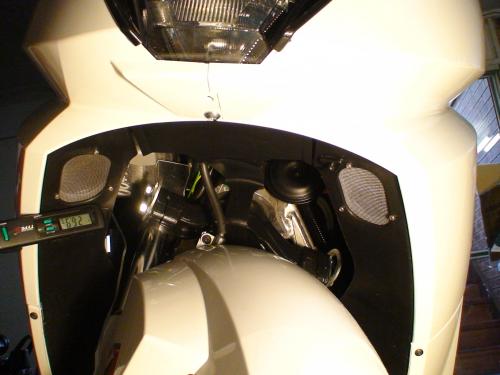
The two air intakes for battery cooling are located on each side above the front wheel, covered with a metal screen.
While I believe that the re-circulation of warmed air is insignificant in cool or warm conditions, it might cause problems when charging in very hot conditions.
----------------------------------------------------------------------------------------
The actual time needed to recharge is much longer than I expected.
No matter how I try to interpret the published specs, I cannot get anywhere near 80% recharge in 2 hrs.
This might be due to the current temperatures here in Australia. I was told that charging takes longer in warmer weather; the charger supposedly slows things down in order to protect the batteries from getting too hot. I think I was told that the published specs for recharging time are for 20 or 21degC ambient temperature.
The lowest ambient temps during which I could observe charging yet were about 23-24degC, the highest 28-29degC.
Assuming that the various stages of the charging process are doing something worthwhile to the battery, I try to let the charging run through the complete cycle when I can.
The recharging time from empty to full, including all stages automatically done by the charger, takes typically 5 ½ hrs and uses about 5kWh electricity.
(5h46min was the longest, 5h26min the shortest).
During the first two hours of charging about 50% of the available battery capacity is recharged.
This means 120min charging for 25 km range gain for my Vectrix, but only when the battery is more than ½ empty.
I need to charge about 4.8min for each km range I need to add when I “top up” somewhere to make it home.
If the battery is already ½ full or fuller when charging begins, then it will take longer to fill it completely than to get to 50% from empty, because during the later stages of charging the current going into the batteries is reduced.
In my experience a 80% recharge is achieved in about 3 to 3 ½ hours.
I have not done any range testing after partially charging my Vectrix.
I have not tested if the estimated range indicated by my Vectrix after partial charging, without the conditioning usually done automatically at the end of each charge, is any more or less reliable than after full cycle charging.
---------------------------------------------------------------------------------------
Here is what my Vectrix usually does when it gets plugged in to recharge:
The lights flash briefly and all instrument panel lights come on for a moment.
The throttle and all systems have their usual function disabled, making it impossible to accidentally drive off whilst plugged in. It does not matter if the key is in the "ON" position or not.
Even after completion of charging some of the usual functions of my Vectrix remain disabled, especially the ability to be driven off whilst plugged in.
If however the power is out, but the power plug is still plugged in, then my Vectrix is unable to detect this and could potentially be driven off, damaging the chord. (The power points in Australia usually have a switch next to them to turn them on or off, so this scenario is not as unlikely as it might seem!)
The instrument panel is used to display different information during charging than during driving:
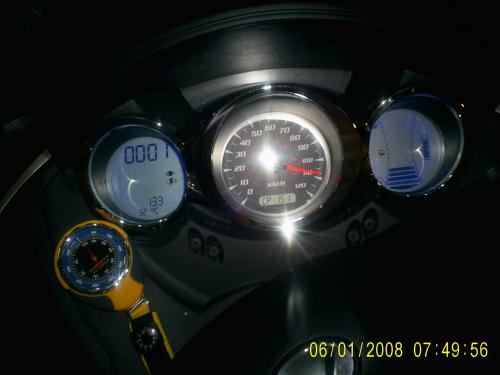
Time of day becomes charging time (00:01), EST RANGE becomes actual battery voltage (133).
Trip A/B meter becomes “temperature of the hottest battery cell” (32 degC)
Speed becomes Amp (DC) going into the battery (108km/h = 10.8A), total km becomes CP, tr, CC or EC + voltage that the charger is aiming at (CP 150)
.
The battery level indicator still shows how full the battery is, and gradually rises during the charging process. (5/17th = 29.4%)
At the same time the battery cooling fans start running, sucking in air from the R + L front fairings meshed inlets and exhausting it onto the rear wheel.
The charger cooling fans also start to run at the same time, blowing onto the front wheel as mentioned above.
Altogether this is quite noisy. The noise levels remain constant throughout the charging process.
This video gives you an idea of the noise level and of how the measurements were obtained:
At the same time that the fans begin to run the speed indicator rises to about 110km/h, which (divided by 10) tells you that the charger is putting 11A DC in to the batteries, and “CP 150” or “CP 151” or “CP 149” is displayed, for “Constant Power aiming at 150V”. I don’t know why the Voltage aim is slightly fluctuating.
---------------------------------------------------------------------------------------
The charging stages are:
CP = Constant Power; takes several hours depending on battery level.
tr = transitional ; always is 14minutes, counting backwards.
CC = Constant Current; lasts variable amount of time; speedo always shows 30km/h steady during CC.
EC = end of charge, always 59min, counting backwards.
----------------------------------------------------------------------------------------
After the end of EC the fans stop, all lights and instruments go out and the ingoing current drops to about 0.5A, fluctuating very slightly.
Just before switching off the instruments display the total charging time, and then 00:68 for a second. No idea what that means.
----------------------------------------------------------------------------------------
The battery temperature is initially always displayed as 21degC, then jumps up after about a minute, then slowly reduces by a few degrees over the next few hours whilst charging.
I cannot make much sense out of these battery temperature readings.
The initially displayed 21degC is obviously incorrect, because it is always 21degC even when the ambient temp is around 30degC and if the battery temp is around 40degC after a fast ride.
The battery temp then usually shows about 33degC after a minute or so, even if the Vectrix has been standing around for several hours or overnight to let the batteries cool down, and in an ambient temp of 24degC. I do not understand why.
After the fans have been running for a few minutes the temperature display begins to slowly drop.
The above picture was taken after a 10 hour break after driving, because I was told that letting the batteries cool down would make the charging process quicker. I wanted to test that statement. Noteworthy is that the temp of the hottest battery cell is already 32degC, despite the ambient temperature of 25degC for the last 10hrs in this example.
The following pictures have been taken later during the same charging process.
The highest battery temp I have ever seen displayed at the beginning of charging was 44degC after a fast and almost complete discharge by fast driving.
The displayed battery temp gradually reduces to somewhere in the mid- to low thirties during charging. It remains fairly stable even when the Amps are reduced during the following charging stages.

Here the displayed temp has dropped to 31degC after 2 min of charging.
---------------------------------------------------------------------------------------
I have not observed any stops or current reductions during charging due to high temp or other issues, but twice I found that my Vectrix had only charged to 15/17th when I turned it on the next morning; the charging process had stopped spontaneously for an unknown reason.
It was not hotter than usual, and there was no power outage, and it was not on the timer.
This is out of a total of 35 charges so far, in other words in about 5% of charging episodes the charger failed to automatically charge the battery to full capacity, but charged it to over 90%. It then took about two hours to let the charger run again until it stopped automatically with a full battery.
----------------------------------------------------------------------------------------
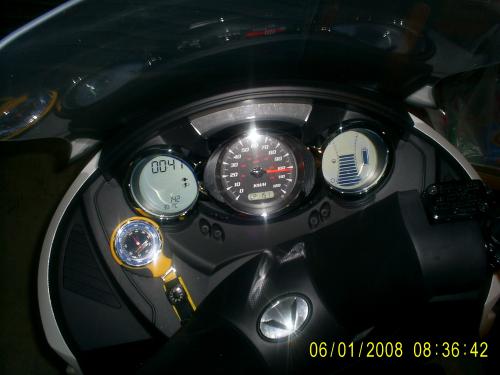
Temperature at 41min is 30degC.
During the “CP” part of charging the displayed DC Amp slowly drops from 11 to 10 Amp over several hours.
----------------------------------------------------------------------------------------
The ingoing AC power is around 1600W, with a peak at around 1700W in the first ½ hr of charging, and appears to remain stable.
It draws about 6.7A at 240V during the “CP” part, and the Amps increase if the grid Voltage drops.
My Vectrix seems to automatically draw more amps to keep the ingoing wattage constant, if the grid voltage drops. Here is a presentation on you-tube where the presenter (I don't know who he is) states that the only difference between Vectrix’ for different countries is a different plug, and that the charger automatically adjusts to different voltages. There is other interesting information relating to this report in the video as well.
----------------------------------------------------------------------------------------
Here is a photo of the display after 2 hrs of charging - the initially missing 70% battery charge have not been completely filled up yet.
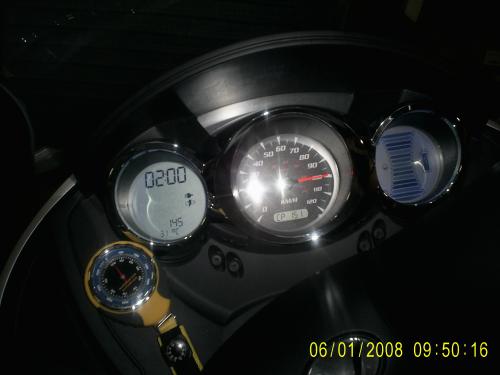
----------------------------------------------------------------------------------------
Once the battery is almost full the “tr” part of charging starts and it appears to be always 14min long. It counts backwards from 00:14.
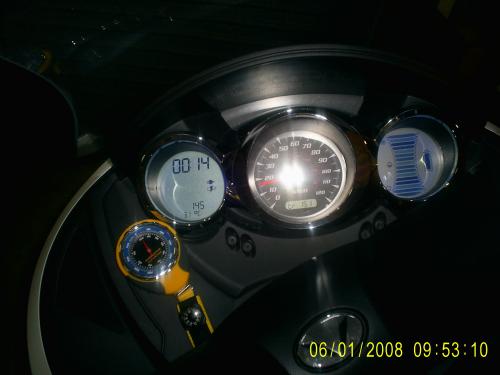
It has the lowest current displayed (and measured going in) of all parts of the charging process, almost always 1.6A DC (=16km/h displayed) and 1.29A going in.
It is supposed to be a “transitional” period to cool the batteries before the next part, but the displayed battery temp does not usually drop during the ‘tr” part.
----------------------------------------------------------------------------------------
After 14min of “tr” charging the DC current goes up to 3A DC (30km/h displayed) and the km counter shows “CC 152” for “Constant Current aiming at 152V”.
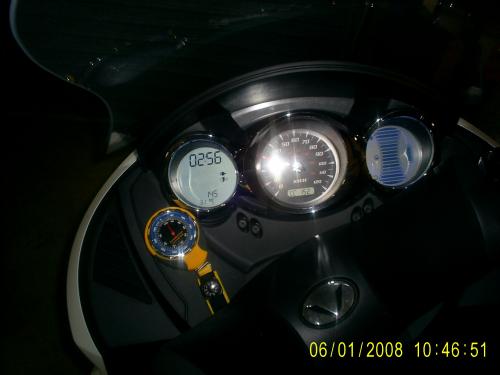
This can last several hours.
It draws about 2.06A at 240V = 494W during the CC part.
Looking through my photo records I just noticed that the "tr" can be followed by another "CP" cycle, then another "tr"; this happened on one of the occasions when my Vectrix did not spontaneously reach 100% full battery through the automatic charging process, and needed another 2.5hrs top-up the next morning to reach the end of the charge cycle.
----------------------------------------------------------------------------------------
Finally there is a “EC” part for “End of Charge” which counts down from 59min to zero.
It draws about the same amount of power as the "tr" part, probably just cooling the batteries, not sure.
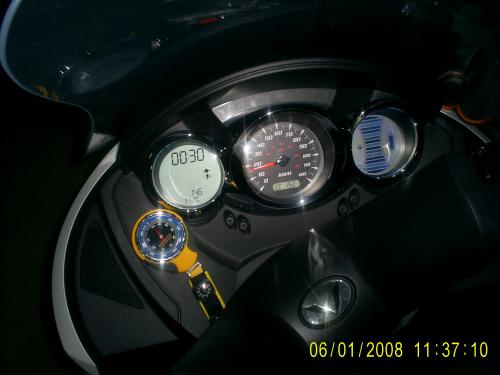
----------------------------------------------------------------------------------------
Overall 4.2kWh were used in this charging process. 1747kWh was the peak power consumption about 13min after the start of charging.
----------------------------------------------------------------------------------------
At the end of charging my Vectrix briefly displays the total charging time again, followed by “00:68” for one second, then all lights and fans go out and the charger starts to slowly heat up as described above.
I do not know what 00:68 means, but it is there each time I happen to be watching at the end of charging.
In Summary:
It takes about 5 and a half hours to fully charge empty batteries.
Uses about 5kWh for a full recharge.
Apparently it conditions / differentially charges cells.
Very easy and reliable 95% of time.
Partial charging / opportunistic charging is apparently OK.
Noisy due to multiple fans running.
Takes longer than advertised.
Standby power wastage.
Please let us know if you have any ideas how to best "condition" or "break in" the battery on a new Vectrix. It's supposed to be a 40Ah NiMH battery, I believe.
--------------------
Cheers,
Mr. Mik




First, please use as many threads as you want.. there is a whole forum section just for the Vectrix. Place all Vectrix related postings there. If you confine all Vectrix postings to one thread then that thread becomes unmanageably long and hard to use. It's better to use lots of short threads than one long thread.
So, on to responses to the excellent report you gave.
Since the Vectrix uses NiMH batteries the discussion we've had about charging other batteries do not apply. Each battery chemistry has its own considerations for charging. Most of us have some variant of lead-acid batteries whether they are Silicone or AGM or whatnot, and lead acid batteries have their characteristics that are different from NiMH and are different from LI-xyzzy
For example you mentioned maximum ambient temperature. I understand NiMH batteries are harmed if their temperature rises too high (?during charge?) and that's what you said.
Hopefully they did a good job such that charging is that simple of a plug-n-play business. Really. For the price they're charging they had better have done a good job with this kind of fit-n-finish issue. I was talking with some friends at lunch about the Vectrix and when the price came up they whistled and said that's too much. Which tells me that it had better have top notch everything in order to justify "that's too much".
I can't find it now but you mention if you just leave the charger plugged in then it keeps consuming power even though the battery is charged. Hurm, that's not good. One would hope that if the charge cycle is finished it would drastically cut back the power it's consuming...?
Oh, here it is:
Did I characterize it right?
- David Herron, The Long Tail Pipe, davidherron.com, 7gen.com, What is Reiki
Hi again,
thank you for you comments, David.
Yes, you got that right. The power consumption is cut back when the battery is full, but 120W standby power consumption is too much - unacceptable in my mind for a vehicle advertised / marketed to be green.
More specifically the questions I have about the NiMH battery are:
1: would it damage the battery if it is left uncharged for lengthy periods in transit between factory and buyer?
2: should the (recommended by Vectrix) 5 deep discharge cycles be done asap, as in for the first 5 charge cycles, or will they have the desired effect to increase battery capacity even if they are done later or much later?
3: should these deep discharges be done slowly?
4: would it do any damage to draw high amps before the battery has been used for some time (Lead-acid batteries apparently don't like this at all)
5: would it matter if the Vectrix is parked for 8.5hrs after partial discharge, then driven home, then charged up?
6: would it help to make the first 5 or so discharges slow, gentle and uninterrupted discharges with immediate recharging?
7: how deep is a "deep discharge" for a Vectrix - how many out of 17 battery indicators left, or what battery voltage on commencement of charging, or whatever other descriptor of a "deep discharge" could be used to optimally plan the conditioning process?
8: would there be any benefit from leaving the Vectrix turned on after driving until the battery is empty? This would further discharge the battery because the light would be on.
----------------
Any suggestions, anyone?
Cheers,
Mr. Mik
This information may be used entirely at your own risk.
There is always a way if there is no other way!
I have some experience with nimh batteries that I use on my ebike, though I imagine your batteries are a class apart from my cheaper 13AH chinese cells.
1: would it damage the battery if it is left uncharged for lengthy periods in transit between factory and buyer?
No
2: should the (recommended by Vectrix) 5 deep discharge cycles be done asap, as in for the first 5 charge cycles, or will they have the desired effect to increase battery capacity even if they are done later or much later?
No, its a good idea to this when you start using the bike or when they haven't been used for some time.
3: should these deep discharges be done slowly?
I can't see any harm in that. It depends on what the battery management system (BMS) is doing. For nimh packs with no BMS then its wise to charge them then discharge all the way down, its important for the last part of the discharge cycle to be a low rate in order to avoid the possible damage from an inbalanced pack and the possiblity of a cell reversal.
4: would it do any damage to draw high amps before the battery has been used for some time (Lead-acid batteries apparently don't like this at all)
I don't see why this should be the case.
5: would it matter if the Vectrix is parked for 8.5hrs after partial discharge, then driven home, then charged up?
No, all though you will prolong the life of any battery by keeping it topped up, lots of shallow discharges is usually better than a few deep discharges.
6: would it help to make the first 5 or so discharges slow, gentle and uninterrupted discharges with immediate recharging?
I don't see why that would help
7: how deep is a "deep discharge" for a Vectrix - how many out of 17 battery indicators left, or what battery voltage on commencement of charging, or whatever other descriptor of a "deep discharge" could be used to optimally plan the conditioning process?
If the BMS is good then a deep discharge would be until it cuts out but maybe check your manual.
8: would there be any benefit from leaving the Vectrix turned on after driving until the battery is empty? This would further discharge the battery because the light would be on.
I doubt this would be necessary.
It would be intersting to know how the BMS works. Some of the original GM and Toyota EV's made under the california EV mandate were reported to have given several hundred thousand miles, the secret was apparently in the sophisticated BMS and also avoiding deep discharges . Normal cheap consumer nimh batteries don't give such a high cycle life. 4 years is a good amount of time for an ebike pack without a BMS. Some people get much less than this as nimh packs without are quite easy to damage as the cells go out of balance though self discharge and uneven wear. Heat is also generally a bad thing for batteries as they will age quicker if they are hot.
Hi Nick,
thank you very much indeed, most helpful!
I don't understand the exact way the BMS works, but it definitely has one.
It reduces the available power when the battery is getting low; initially it will only go 80km/h, then 60km/h etc.
Even when the battery is so low that the bike needs to be pushed, there is no obvious dimming of the lights, slowing of the battery cooling and controller cooling fans or malfunctioning of the electronics.
When starting to charge up after using all the battery capacity that the BMS allows out of the battery, the initial battery voltage still shows 128V.
-----------------------------------------------------------------------------------------
Here are some pics to illustrate this:
My Vectrix shows 22km remaining estimated range, after having been driven as gently as I could without hindering traffic for 55km. I would not have noticed if the power was already reduced at this stage because I was only going 60-70 in an 80km/h zone.
--------------------------------------------------------------------------------------
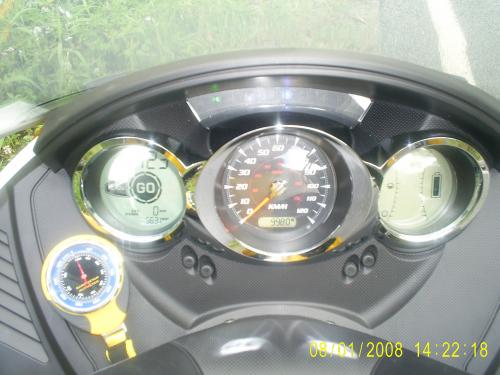
After having driven a further gentle 1.3km downhill in an 80km/h zone the estimated range dropped to zero km.
-------------------------------------------------------------------------------------------
I had to keep crawling along for a further 0.8km to make it home, pushing the bike up the driveway at the end. So this was well and truly empty.....
-----------------------------------------------------------------------------------------
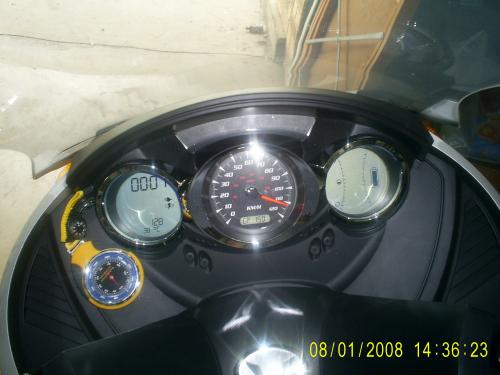
Here is the instrument panel at the beginning of charging:
Highest battery cell temp: 38degC.
Actual battery Voltage: 128V
----------------------------------------------------------------------------------------
Vectrix give the specs of the battery as 125V, so I guess that the BMS stops the voltage from dropping much below that.
Cheers,
Mr. Mik
This information may be used entirely at your own risk.
There is always a way if there is no other way!
Hi,
a new Vectrix was delivered to me today.
I'll try to document the events during the initial charging cycles thoroughly using the setup in the photo below.
This might of course not be the best way to do it, but at least it will enable more informed guesses than before.
Using the flexible tripod in the picture I can video or take pictures whilst driving, using a small camera.
The larger video camera used during recharging (picture) is too sensitive to vibration and would likely bend the tripod out of alignment during driving.
Here is the view from the mounted camera:
It shows the instruments of my new Vectrix just before the first recharge, after the first deep discharge as defined below.
The added instruments are:
Barometer/Altimeter on left side.
Thermometer measuring air temp at left battery cooling air inlet under the front fairing.
Multimeter displaying either V, A (AC), W, W (peak) or kWh (total).
The new bike had 33.9km on the speedo - this is from testing at the factory, so it is a brand new Vectrix this time, which should enable me to document the expected changes during the recommended initial 5 deep discharge/recharge cycles.
I will attempt to follow this strategy:
A) Do at least 5 deep discharge cycles followed by uninterrupted recharging until the charger decides it is finished.
Deep discharge = drive close to home until max speed is reduced to 60-70km/h, then try to get home again and up the long driveway hopefully without having to push.
If I was living in a flat area I would try to drive until the speed drops to 40km/h.
The range meter is expected to be unreliable until the battery has been cycled a few times, so I will need to stay close to home.
B)Once the range has increased sufficiently I will begin to commute to work, meaning that the bike will stand around during the day in a partially discharged state. This will be followed by the drive home and some further back and forth in the neighborhood, until again deeply discharged as defined above.
C)I'll try to continue this until I do not get a significant range increase between deep cycles any more.
D) I'll then occasionally repeat the commuting followed by back and forth in the neighborhood to determine if there is a further (slow) range increase; even later a battery "peak" might be detected that way, and then a gradual decline. (Hopefully much later and very gradual).
E) Avoid regen braking for a while.
Any suggestions on how to improve this "experimental setup"??
If yes then let me know soon, for it's a-charging as I type...
Mr. Mik
This information may be used entirely at your own risk.
There is always a way if there is no other way!
Results of the "deep discharge cycles" so far (see above post for explanation):
First drive: 8.6km (?+ 1.1km already on Trip A meter?)
Second drive: 12.8km.
Third drive: 14.2km
The kilometers driven are demanding ones: About 111kg payload, 80km/h to the speed limit, up and down mild to moderate hills.
And a 0 to 100km/h full throttle acceleration test at 3km, which is repeated after every further 7km.
A steep hill at the end.
Error messages were received several times towards the last 1/3rd of the rides:
"buSULt" in conjunction with the battery telltale coming on. Resolved within 30sec by stopping.
Any idea what that means, anyone? (Yes of course, of course I have asked...but I am such an impatient fella, just can't wait too long).
Odometer shows 69.6km total now.
Mr. Mik
This information may be used entirely at your own risk.
There is always a way if there is no other way!
Sorry, does it mean it went 8.6km, 12.8km and 14.2 km from full charge to speed limitation at 60kmh by driving the way you described above?
I was told the batteries need a certain number of cycles to go up to "real" capacity, but I wonder if it is a bit too low. Anyway maybe I simply miss something.
Interesting arrangement you have for your camera!
Ciao
Friday when I came home from work with strong contrary winds I purposedly didn't put it on recharge, yesterday I drove it to the last bit of charge around my home. I forgot to put the trip counter on zero before starting the road back to work but it must have been something between 50 and 55km. Considering the strong winds and the fact that I didn't drove very gently it is not a bad result I think. Important information for Mik and others interested, might be that when putting the scooter in charge, it indicated a voltage of 119V, the lowest reading so far.
About the logic of the BMS I spoke to the technician of Vectrix Rome some time ago. He told me that the battery protection logic sets in when the battery hits voltages below 108 (?) (the conversation took place some weeks ago so I qouldn't put my money on the correct voltage) meaning that when you accelerate the request to the battery makes the voltage has a "minus peak" so when you accelerate the voltage goes down suddently and than rises again to the mean level of chargenthe battery has reached at that moment. That is why you can have a situation where the BMS has cut off power and you reach home, put the scooter in charge and still read voltages at which you normally don't have the protection mode setting in.
...sort of... ;)
Ciao,
thanks for your reply, sorry about the delay! I've been busy getting my new Vectrix to go further and at the same time collecting data.
Because one never knows what questions one should have asked until wiser, I have taken lots of video and photos. So questions can be asked later.
Most of the documentation might be useless and never get posted, some in PM's.
The distances are how far my new Vectrix went all up.
At the first indication of reduced power (= being unable to maintain 80km/h going uphill) I turned around and headed towards home.
The main issue in this respect is the steep road of 100-200m length that I need to get up at the end.
I never had to do this without any battery power yet - I doubt I could get the bike up if the battery was really, really flat.
Here is a rough diagram of the course I used, going back and forth in order to stay close to a suitable recharging point:

The distances traveled are including the limping home at the end and the crawling up the steep drive at the end, just without pushing if I get it perfectly right....
Shuffling my feet a bit on the steeper parts, or even having to jump off and walk alongside of the Vectrix while it drags itself up the hill towards the plug if I waited a bit too long before turning back...
And no regen-braking at all.
.
And here are the results of drive 4 and 5:
Nr. 4 ( Landslide caused building site, caused delays and slow driving on small part of the course. It's the Real World!)
Odometer Start: 69.6
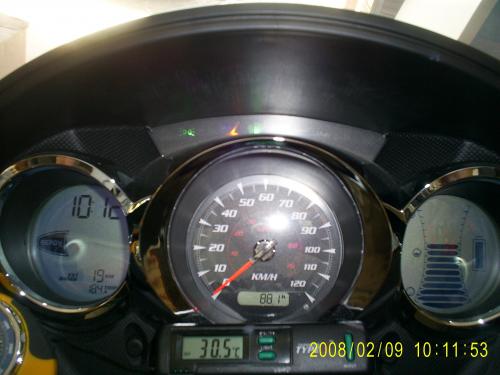
Odometer End: 88.1
Distance traveled: 18.4km
Battery 17th at end: 10/17
.
.
.
Nr. 5:
Odometer Start: 88.1km
Odometer End: 109.6
Distance travelled: 21.5km
Battery 17th at end: 9/17
Sooooo, 21.5km range after 5 days, 5 supposed deep discharge cycles, spending my precious after-hours riding my Vectrix up and down the neighborhood! IMPRESSIVE! ROTFL
So I did a sixth ride (on the same course) in a slower fashion, "sailing" I call it.
"Only an Eco-warrior knows the feeling..." (over 20 years of trying to make ICE and other vehicles go further with less juice).
Using all senses, avoiding the (simulated) emergency braking and all hard accelerations etc. but still avoiding all regen-braking I got this:
Distance traveled: 28.4
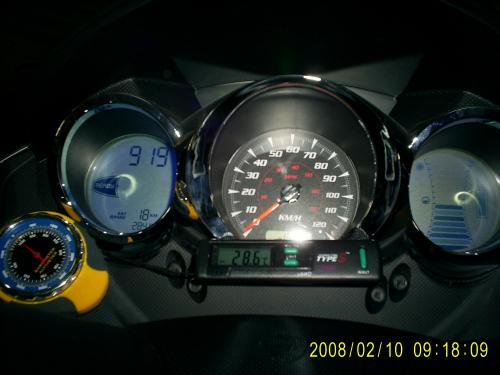
Battery / 17th at start: 17/17
Battery 17th at end: 8/17
Est Range at End: 18km
This had obviously not fixed my problem either.
.
.
Just to be sure I repeated a Nr 7 Deep Discharge with all the power-hungry behaviours as before:
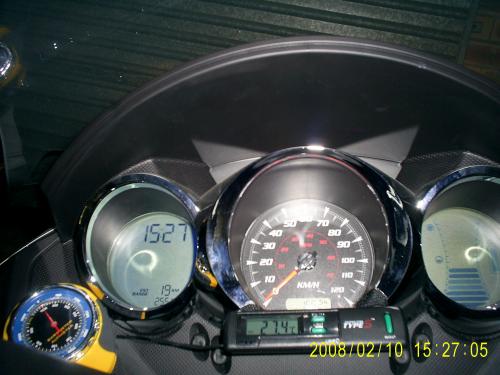
Odometer Start: 139.7km
Odometer End: 165.2
Distance traveled: 25.5km
Battery / 17th at start: 17/17
Battery 17th at end: 7/17
Est Range at Start: 25km
Est Range at End: 19
.
.
.
I developed a hypothesis (which has held up beautifully) and an approach to fix the problem.
Have another look at my playground to help you work out what the problem is:
(I live more towards the hilly side of things; there are 500,000 people on the flat part, and traffic lights galore!)
The elevation is exaggerated to make things clearer.
Mr. Mik
This information may be used entirely at your own risk.
There is always a way if there is no other way!
Mr. Mik...
So if I follow you correctly you are unable to completely discharge the battery because of the grade of your neighborhood & driveway??
How far can you take the battery down too before your... stuck?
When breaking in my bike I always took the battery pack down, actually past what was displayed as 'empty.' Riding around my neighborhood loop of about 1 km. I would usually ride what would equate to about 6-8 km past when my range was 0 and my battery was dead. Performance was down naturally. I would return home once the battery telltale lit for five seconds.
To quote the Vec-Tech this is when the battery is reset.
I'm not sure but i would imagine that is the same thing as the BMS reseting.
He said it was recomended to complete my software update.
Which brings me to my next point... When I broke in my bike it was the 'bad' software, so the range & battery display behaves much different that it does now.
Has anyone ever taken a battery down so far that is shuts off or dies? I've taken mine down to were the top speed is maybe 20mph. Any ideas if theres any fail safes or such? What would happen?
As described above - I drive until I just make it up the steep part at the end.
I simulated this approach by putting my Vectrix on a block and running the engine with the wheel spinning freely.
This is much safer than limping around in traffic without any real power left.
It is a lengthy and potentially dangerous process and it should be done before delivery to the buyer.
There simply must be a best way to condition the battery, and a laptop computer connected to the CAN Bus of a Vectrix on a treadmill with adjustable resistance should be able to apply it. It would take roughly 7 hours for a full charge/discharge cycle, and it would need to be done in a safe area because the spinning wheel will do damage if treated carelessly.
Seven rather than 5 deep discharges are needed in my experience.
This means a Vectrix shop could condition one Vectrix at a time with a laptop and a treadmill of sorts; two deep cycles could be done per day if the shop is open for 9 hours (turn on discharge first thing in the morning, recharge, discharge again, recharge overnight).
A second or third Vectrix could be on the treadmill while the first is recharging for 5 hours.
It would take 3.5 days to prepare a Vectrix for the buyer and would add several hundred km to the odometer, but this could be reset electronically to zero.
That way a fully roadworthy vehicle would be delivered to the customer.
Note the difference in battery indicator behaviour compared to my first Vectrix:
The indicator still shows plenty of remaining battery when it is indeed empty.
The old one would show charge until this displayed charge suddenly dropped away to zero.
More on this later.
Mr. Mik
This information may be used entirely at your own risk.
There is always a way if there is no other way!
"buSVLt" appears in the right display and the battery telltale comes on. Sometimes both, sometimes one, in any order. They seem to be semi-independent.
Easing off on the throttle or stopping altogether makes the error message disappear within a few seconds.
The BMS appears to protect the battery very effectively from being discharged too deeply - the software, fans and lights run unchanged even if it can barely crawl along any more.
Mr. Mik
This information may be used entirely at your own risk.
There is always a way if there is no other way!
I think this is correct, including the 108V.
Maybe the "buSVLt" message stands for "Battery under specified Voltage"?? I was told it is a normal warning that the battery is low, not a fault.
PM me if you need to know details.
Mr. Mik
This information may be used entirely at your own risk.
There is always a way if there is no other way!
How to best break in a Vectrix - Hypothesis I
Here is the hypothesis I came up with after the dismal failure to condition the battery of my replacement Vectrix by driving in very hilly country.
There are three parts to it, and I emailed it to Vectrix on Feb 11th, 2008. I have not received a reply regarding the validity or otherwise of my hypothesis.
But it has held up beautifully as far as I can say.
Here it is, only slightly changed from the email:
(I started the free spinning deep discharges from ride Nr 7 onwards to ride Nr 13.)
.
It took indeed exactly seven deep discharge cycles with the wheel propped up until I was able to take this picture:
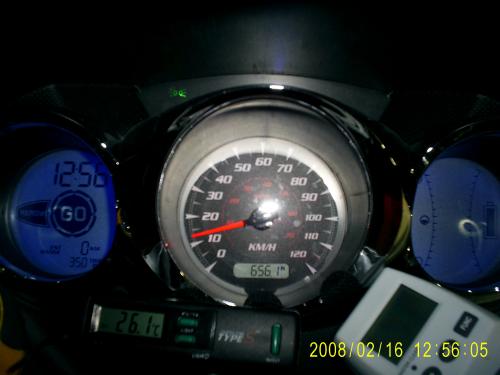
Zero range, zero battery left, and battery actually empty! Jippie!
Mr. Mik
This information may be used entirely at your own risk.
There is always a way if there is no other way!
Here is how I get the rear wheel off the ground:
Best done with a capable helper, but can be done alone with the right jack.
Be aware that this is all quite risky - the Vectrix is heavy and powerful and will do serious damage to itself and anything that gets caught under it's weight if it falls.
If you flick the side stand up the Vectrix will behave as if on the open road, and has some potential to inflict lethal injuries to people and pets if given the opportunity.
As I wrote earlier: All this should be done before delivery/hand-over to the buyer, but hey, it's about solutions for the Real World. Be careful.
It's rock solid once it's "on the Rock":
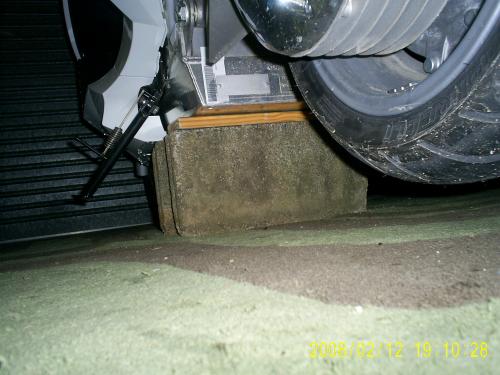
.
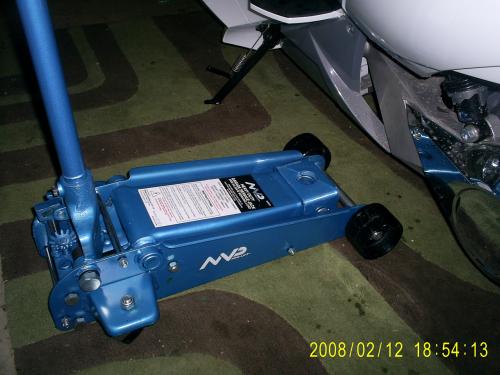
Remove round swivel metal piece from jack to provide a flat surface for the Vectrix to (precariously) balance on:
Remove grey plastic pieces on both sides:
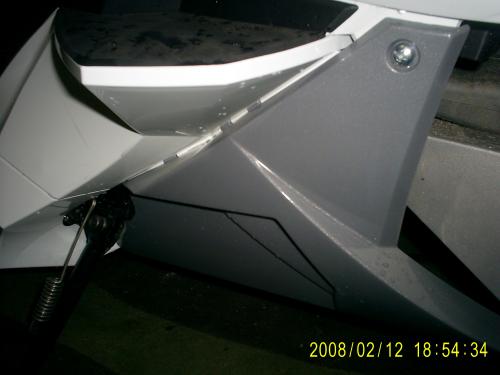
Best spot to place the jack in my experience it the rear cross member of the swing arm (or whatever you call the spot in the photo below):
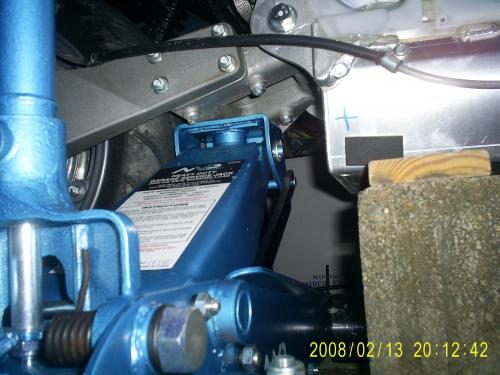
Stand behind the bike, hold onto passenger hand rail and pump jack up gently, checking that the Vectrix is balancing. It's a small pivoting plane, but it works if you get the jack in the right spot.
Once high enough push in the rock with a piece of timber on top to prevent scratches.
Don't bump the bike - it will fall off the jack easily if knocked.
This concrete block and timber was lying around and worked perfectly (God helps those who help themselves...!):
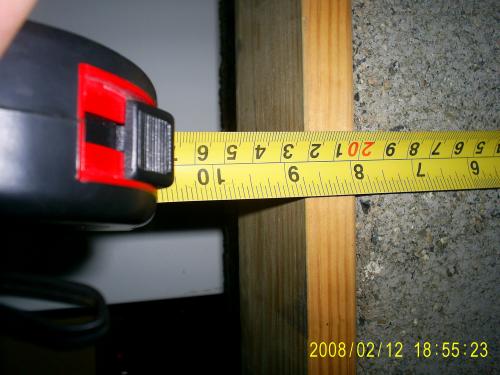
Lower the jack until the bike sits safely on the Rock.
Remove the jack - it might turn into a nasty missile if the spinning wheel catches onto it.
Mr. Mik
This information may be used entirely at your own risk.
There is always a way if there is no other way!
This might be a much better option if you need to get the rear or front wheel of you Vectrix off the ground:
"The Strong Arm"
http://www.oneup.com.au/default.aspx?page=Strong%20Arm
The only problem might be that you need to spread the load a bit further to avoid bending the aluminum battery box.
I have not tested it.
Mr. Mik
This information may be used entirely at your own risk.
There is always a way if there is no other way!
I have a standard motorcycle lift .. it's a hydraulic jack, that's very similar to a floor jack but it has a flat platform and places to connect tie-down straps. Works very well and I kept the Lectra on it for 2-3 months while working on initially getting it going. As for "spreading the load" the top of the platform is wide, flat, etc, and would do very well to spread the load. And at U.S.$100 it was very affordable.
- David Herron, The Long Tail Pipe, davidherron.com, 7gen.com, What is Reiki
Hallo Mik,
Beside the hazard of running the Vectrix at full throttle with rised rear wheel via a woodden block under the chassis I'm concerned about the practice to let the motor spin free with no load until full depletion of the battery. I cannot give you a thorough technical reason for this, but it just "feels wrong" :) (no offense intended) . Hope some more knowledged can expand on this.
Regards
Besides: how is going with the technical responsible of Vectrix Australia? Are you seing some light at the end of the tunnel?
Well, what to do when you only get 25.5km total range after 7 "deep discharges" including having to push up the driveway a far bit a few times?
Before my second Vectrix died I tried if I could possibly push it up the driveway: NO WAY! I stopped and applied full breaks on the steepest part of the driveway; the Vectrix pushes me down the hill like a toy as soon as I loosen up on the breaks. That was with me standing next to it, braced and ready....
So I do not have the option to discharge my Vectrix by riding on the flat until ready.
Besides, I think that would be a lot more dangerous than "on the rock" due to limping around in traffic in a basically non-roadworthy state for extended periods.
As a reminder, here is the instrument panel after 7 "deep discharges on the road":
It shamelessly claimed 7/17th left in the battery, and 19km range left, although I almost had to push it up the driveway (at that stage I had become quite proficient at getting it just right, or maybe it was luck)!
One could of course still assume that riding on flat ground would have continued for a further 19km and would have brought the battery display down to 0/17th.
.
This is the result of putting it "on the rock" instead:
As you can see, there was enough left in the battery to go a further 29.2km with a free spinning wheel. But the battery indicator still claimed 6/17th left in the battery.
I never said anything about "full throttle" on the rock, nor about "full depletion of the battery".
Initially, nowhere near "full throttle" is needed to get the wheel to spin freely at almost full speed; later the throttle needs to be pulled back harder gradually as the battery power is reduced. That's why I estimated (in another "V" thread) that I would have to charge AU$700.- to condition a Vectrix battery using this approach. It takes someone to stay with the propped up scooter and operate the throttle so that it does feel right!
The battery cannot be depleted by using the motor, because the BMS stops power delivery to the motor below a certain voltage, I believe 108V.
You missed all this fun stuff because your Vectrix had over 200km/h on the clock when you got it. I guess your dealer did the right thing and conditioned it for you!
Mr. Mik
This information may be used entirely at your own risk.
There is always a way if there is no other way!
Well, this actually looks weird... 19km left and almost half "ladder" full. If the places you are driving through are really very steep (and I truly mean steep) I could imagine that this reading could come close to reality: 25.5km driven + 19km left are some 44+ km. Assuming you have no more than 10-15 "real" km left this would bring to 40km range which is what could be expected for in very "hilly" ground. The reasioning behind this being that, if they declare 40km at 100km/h I could assume that the power (ab)used by the motor by driving at less than characoal speed on steep hillsides can be comparable to driving at 100km/h on the flat... I don't know if I even understand myself :) I can imagine further that you made very little use of regen-braking because your goal was to make a deep discharge in the shortest time possible. So it looks weird at first sight but if all assumptions made by me are OK it should be not unreasonable.
How are your contacts to the Vectrix assistance so far? Hope the best for you :)
Ciao!
The hills are not that steep, just the driveway at the end.
When the battery is full the Vectrix can maintain 100km/h up any of these hills.
No regen braking used at all during these attempts to condition the battery, as described above.
Unfortunately, after 7 of theses cycles the range was still utterly insufficient for commuting (I need 40km of grunt!)
Mr. Mik
This information may be used entirely at your own risk.
There is always a way if there is no other way!
40km should be in the battery all the time, when fully charged: this is really strange.
I commute 45km each leg and I still have some km left when I arrive... has Vectrix nothing to say on the subject?
My blue jack was AU$100.- and putting a larger platform onto it would enable lifting of the Vectrix from underneath the battery box. But then the jack would be where the rock needs to go; and the Vecrtix would have to remain on the jack, like your Lectra.
This would carry some risks: A slow hydraulic leak could drop the bike when it is unattended, and a thoughtless twist of the jack release mechanism could drop it suddenly.
Does you bike jack have a "locking mechanism" of sorts to prevent this?
This information may be used entirely at your own risk.
There is always a way if there is no other way!
As I wrote before, you missed the battery conditioning process because your scooter had 200km on the speedo when you got it.
Mr. Mik
This information may be used entirely at your own risk.
There is always a way if there is no other way!
Yes, there's a metal bar that slides through some holes once the jack is raised. If the hydraulics were to give out the bar would hold everything.
- David Herron, The Long Tail Pipe, davidherron.com, 7gen.com, What is Reiki
The hypothesis was wrong, I believe I now understand what actually happened!
I have reviewed the video and photo footage of the initial 9 rides on the (now) Vectux, and it seems quite clear that I was watching the instruments like a hawk and eased off the throttle very quickly each time that either the battery telltale or the buSVLt message came up.
Therefore a reset of the "empty" point of the battery was avoided and the charger only partially charged the battery each time after the rides.
They were indeed deep discharges, but they were not followed by full recharges!
I should have held the throttle wide open for a few seconds longer when the error messages were displayed.
Had I done this, the battery charge display and range display would have dropped to zero, and the next recharge would have gently over-charged of the battery to equalize the cells, limited by either a top voltage of 152V or a max cell temperature of 45°C.
Unfortunately advice to do this was not given to me by Vectrix Australia. I do not know where exactly it all failed, but despite my repeated, clear descriptions of the problem the correct diagnosis was not made, and I was not advised to affect what I now call a BaLPoR. (=Battery Low Point Reset).
The real cause of the problems described in this thread was in my (now much more informed opinion) that the battery was 3/4 empty on delivery of the scooter.
This was due to spontaneous self discharge, as NiMH batteries do, coupled with a lack of compensation for this by the Vectrix electronics. The electronics assumed a full battery because they lack memory of the time elapsed since the last recharge.
And that scooter had been inactive for many months, in all likelihood about half a year.
Therefore the display showed still 3/4 full when the battery was empty after riding 9km; and after the ride, charging stopped long before the battery was anywhere near full, because the electronics "saw" a 16/17th full battery meter and therefore switched to tr, and CC, and EC, as they are programmed to do.
I might be able to verify this hypothesis/theory during my upcoming "battery rework" on ES. I'll rework it myself to be sure to be sure...
(I'll post it on ES because there seem to be more users with an interest in NiMH batteries there than on V.)
I might remove the batteries after discharging them to about 50% DOD (just by riding), and then run a capacity test on each cell which will discharge each of them to the same cutoff voltage level.
After that I could re-install a balanced, but empty pack into a Vectux which is expecting a half full pack.
It should therefore only use about 60% of the normal amount of energy usually needed to recharge after a deep discharge, and display the battery as "full", but with a voltage of only 142V or so.
During the following test-ride I should be able to observe a BaLPoR after only about half the usual range has been traveled, with 9/17th disappearing from the display in one hit at full throttle.
We shall see.
Mr. Mik
This information may be used entirely at your own risk.
There is always a way if there is no other way!
I quite agree Mik, what a shame we can't attach some medium load device to the battery terminals, well, on the other side of the BMS of course, to discharge the battery to a safe but deep discharged level.
A resistance device producing heat would be nice, like a type of fan heater, especially if we did our discharging/conditioning in the winter time when we needed a little more heat in our homes.
Far better than trolling round the block trying to guess the moment the machine grinds to a halt only to have to push it home.
To have a small 125v fan heater on an extension cable into the house/garage/workshop etc. would be grand. The BMS would simply cut the power when the voltage reached the low threshold, then we could simply recharge the little beastie!
I have to say it can't be difficult, I don't know too much about electronics, unlike you and Ray, but I do have 3 AA battery chargers which do an auto condition. On one of them you can even set the discharge rate, the charge rate and the number of cycles you want to do (it's made by Maha if anyone is interested, it really is superb). At the end of the program the batteries are simply charged ready for use. It's a fabulous charger and has "brought back" and increased the capacity (which it confirms on an LCD display) on many of my older NiMh AA and AAA cells.
The nice thing with this feature is that you can match up a ropy old 2500 Mah cells giving out only 2000 Mah with a good 2000 Mah cells to reduce the situation of one bad cell bringing down the whole pack.
So, a small fan heater from the USA (125v) connected to where the motor normally takes its power from, left on low setting, making sure it's current draw is well within safety levels, lets say 1/4 to 1/2 of the motor consumption.
Am I being naïve here or could this be a possibility? As you state Mik, running the Vectrix on a block is a nice safe way for the electrics but is fraught with mechanical dangers such as, perish the thought, a runaway if it became free.
Rgds
Simon.
Simon
Yes, but even better if the power would be fed back into the grid, like with photovoltaic and other grid conected generation systems.
Then you could even condition your EV in the summer heat and your meter would run backwards!
Mr. Mik
This information may be used entirely at your own risk.
There is always a way if there is no other way!
When I got My new battery after the recall, they were precondition . No need to drive around the block .
I was told they are using some type of varable load discharge to it.
Happy riding , Herb
I have owned a couple of Chevrolet S10e pickups with 85 amp hour NiMH batteries. Bringing back the batteries from dead is a process similar to the conditioning Vectrix is trying to do to get the maximum range out of new batteries. To fully discharge the batteries I used a device called an electronic load. The proper way to discharge the battery is with a constant current. If you use a resistive load, the current the battery provides will fall over time as the terminal voltage drops. The S10e batteries had eleven cells per battery and each cell needed to be monitered for voltage. Starting with a full charge, the battery was discharged with a constant 20 amp load until one cell in the battery dropped to one volt. The battey was then recharged at 20 amps until one cell reached 1.45 volts, then a 3 amp charge was applied to equalize. This cycle was repeated (sometimes up to 10 times) until the available amp hours increased and the cells equalized. Monitoring the cell voltage is very important as the battery discharges. As the cell approaches 1 volt, it is totally discharged and with constant load the cell may drop from 1 volt to 0 volts in a matter of less then a minute. This is destructive to the cell. The bms in the Vectrix will not allow you to get to 1 volt per cell as there is a little cushion built in because not all cells are monitored. Driving at a constant speed until the bms senses low voltage and shuts down the vehicle will get you the best discharge for battey conditioning.
Pages